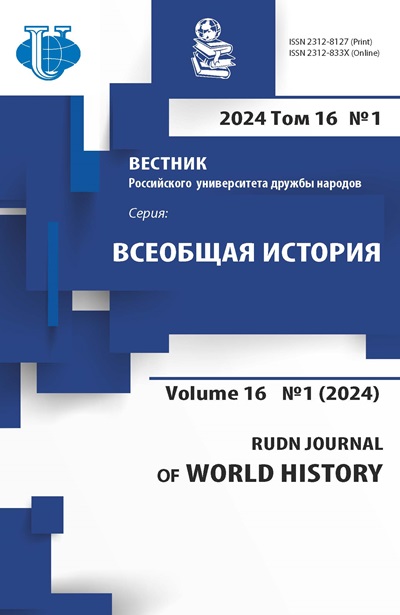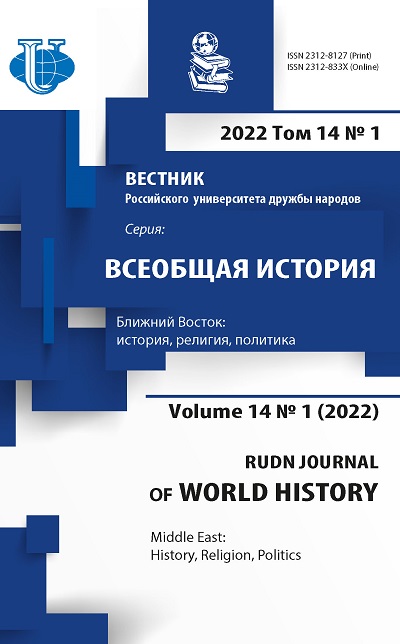Formation of the national political elites in Sudan in the Interbellum
- Authors: Matrosov V.A.1,2, Shalupkin V.V.1
-
Affiliations:
- National Research University “Higher School of Economics”
- State Academic University for the Humanities
- Issue: Vol 14, No 1 (2022): Middle East: History, Religion, Politics
- Pages: 43-58
- Section: Political History of the East
- URL: https://journals.rudn.ru/world-history/article/view/30336
- DOI: https://doi.org/10.22363/2312-8127-2022-14-1-43-58
Cite item
Full Text
Abstract
This work aims to study the formation of national elites in Sudan in the interbellum as this very period predetermined the country’s history since gaining independence in 1956. Within this article relations between three main groups are considered, namely religious, military and civil elites. The study is divided into three main parts. The first one concentrates on the history of Sudan before 1918, the second one is devoted to the interwar period, the third part aims to study the development of Sudan in World War II and the first post-war years. The special emphasis is given to the Sufi Tariqas as being not only religious but firstly political institutions. Directly within the context of Tariqas’ political and social influence, this article aims to study the formation of movements, political parties and associations, whose representatives later entered the political authority of the country. The Sudanese specifics of the national elites’ formation studied in this work is that the conservative religious elites managed to maintain the leading position within the struggle between traditional and modern political powers. The work explains how the inner nature of these elites, as well as their relations with the military and civil elites, predetermined the subsequent events.
Keywords
About the authors
Valeriy A. Matrosov
National Research University “Higher School of Economics”; State Academic University for the Humanities
Author for correspondence.
Email: vam_179@mail.ru
lecturer of School of Asian Studies, Faculty of World Economy and International Affairs (HSE University), lecturer of Faculty of Oriental Studies, State Academic University for the Humanities
11 Pokrovskiy boul., Moscow, 109028, Russia; 26 Maronovskiy Lane, Moscow, 119049, RussiaVadim V. Shalupkin
National Research University “Higher School of Economics”
Email: vvshalupkin@edu.hse.ru
student of School of Asian Studies, Faculty of World Economy and International Affairs
11 Pokrovskiy boul., Moscow, 109028, RussiaReferences
- Musso G. The making of fragmented nation: Sufi turuq and Sudan`s decolonisation, Oriente Moderno. 2017;(97):133–153.
- Warburg G. From sufism to fundamentalism: the Mahdiyya and the Wahhabiyya, Middle Eastern Studies. 2009;4(45):661–672.
- Lutskiy VB. Novaya istoriya arabskih stran [New history of the Arabic countries]. Moscow: Publ. Nauka; 1966. (In Russ.).
- Smirnov SR. Mahdistskoye vosstaniye v Sudane [The Mahdist rebellion in Sudan]. Moscow, Leningrad: Publ. Izdatelstvo Akademii Nauk SSSR; 1950. (In Russ.).
- Niblock T. Class and Power in Sudan. The Dynamics of Sudanese Politics, 1898–1985. London: The Macmillan Press Ltd.; 1987.
- Novaya i noveishaya istoriya Sudana [The Modern and Contemporary History of Sudan]. Moscow: Publ. Nauka; 1992. (In Russ.).
- ‘Uthman T. Tarikh al-Khatmiyya fi-s-Sudan [History of the Khatmiya in Sudan]. Al-Khartoum: Publ. Manshurat Dar Saqina wa-l-Mamun; 1999. (In Arab.)
- Powell ET. A Different Shade of Colonialism: Egypt, Great Britain, and the Mastery of the Sudan. University of California Press; 2003.
- Polyakov KI. Istoriya Sudana. 20 vek [The History of Sudan. 20th century]. Moscow: Publ. Institut Vostokovedeniya RAN; 2005. (In Russ.).
- Voll JO. Wahhabism and Mahdism: alternative styles of Islamic renewals, Arab Studies Quarterly. 1982;1–2(4):110–126.
- Al-Faki ‘A. Tarikh quwwat difa’ as-Sudan [The history of the defense forces in Sudan]. Al-Khartoum: Publ. Ad-Dar as-Sudaniyya; 1971. (In Arab.).
- Ibrahim ‘A. Husayn Sharif: Sha’b bila djarida ka-qalb bila lisan [Hussain Sharif: A people without a newspaper looks like a heart without a tongue]. Available from: http://www.sudanile.com/107202 [Accessed 14.10.2021]. (In Arab.).
- Kramer R., Lobban R. Historical Dictionary of the Sudan. Scarecrow Press; 2013.
- Ad-Duri Z. At-tadjammu’at al-wataniyya fi-s-Sudan [National alliances in Sudan]. Available from: http://www.sudanile.com/94975 [Accessed 14.10.2021]. (In Arab.).
- Anglo-Egyptian Treaty of Alliance. 1936. Available from: https://upload.wikimedia.org/ wikipedia/commons/d/de/Anglo-Egyptian_Treaty_of_1936.pdf [Accessed 12.10.2021].













